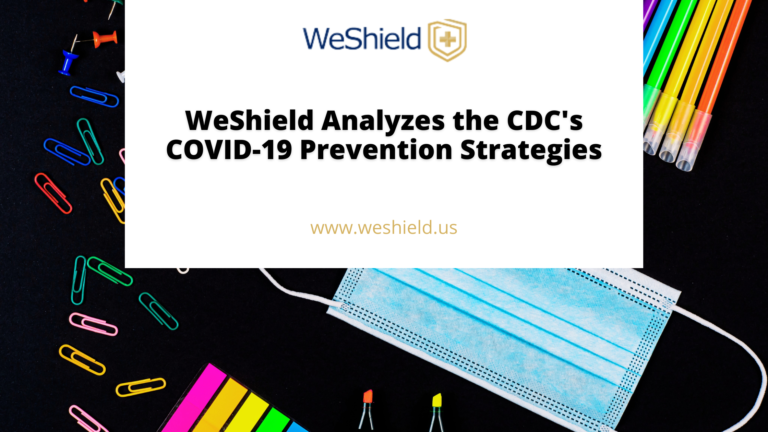
Summertime is coming to an end, and the time to go back to school is just around the corner. However, as COVID-19 and its variants dominate globally, many of us are concerned about what this means for our educational system.
According to the CDC, schools must use layered prevention strategies regardless of the level of community transmission. The CDC has shared five essential prevention strategies that must be implemented for the spread of COVID-19 to be reduced in schools.
Below, WeShield analyzes the CDC’s COVID-19 prevention strategies and what this means for our children, educators, and staff in school.
First, the CDC recommends the universal and correct usage of masks. Students, teachers, and staff should always wear a well-fitting face mask with a proper filtration system to prevent COVID-19 transmission through respiratory droplets.
In schools, all personnel should wear masks at all times, with certain exceptions for specific individuals or certain locations or activities, such as food and beverages. In addition, classrooms and non-classroom settings should require masks, such as hallways, school offices, bathrooms, gyms, auditoriums, etc.
Secondly, the CDC recommends physical distancing in the classroom and elsewhere on school property. While physical distancing can be problematic, especially in smaller classrooms, school policies should implement structural interventions to promote physical distance between people.
For example, in middle and high schools, students should be at least 3 feet apart in low, moderate, or substantial community transmission areas. In areas of high community transmission, students should be 6 feet apart. Additionally, many schools are conducting a staggered schedule, arrival and drop-off times or locations by cohort, or put in place other protocols to limit contact between affiliates and direct communication with parents.
Core principles for hand-washing and respiratory etiquette will be upheld through ongoing health education units and lessons, teach children proper hand-washing and reinforce behaviors, and provide adequate supplies. Ensure that teachers and staff use proper hand-washing and respiratory etiquette.
Schools should also teach and reinforce hand-washing with soap and water for at least 20 seconds and increase monitoring to ensure adherence among students, teachers, and staff. If hand-washing is not possible, hand sanitizer containing at least 60% alcohol should be used.
WeShield also encourages supporting healthy hygiene behaviors by providing adequate supplies, including soap, a way to dry hands, tissues, face masks (as feasible), and no-touch/foot-pedal trash cans. Suppose soap and water are not readily available. Schools can opt to provide alcohol-based hand sanitizer that contains at least 60% alcohol (for staff and older children who can safely use hand sanitizer).
The CDC also recommends changing physical spaces to maintain a healthy environment and facilities, including improving ventilation. In addition, schools should routinely clean high-touch surfaces (such as doorknobs and light switches).
Improve ventilation to the extent possible to increase outdoor air circulation, increase the delivery of clean air, and dilute potential contaminants. If possible, close communal use of shared spaces, such as cafeterias; otherwise, stagger use and regularly clean (for example, daily or as often as needed).
In the CDC COVID-19 Prevention Strategies, the CDC suggests that schools collaborate with the health department, to the extent allowable by privacy laws and other applicable laws, to provide information about people diagnosed with or exposed to COVID-19 confidentially. In addition, students, teachers, and staff with positive test results should isolate, and close contacts should quarantine.
Schools should report positive cases to the health department as soon as they are informed. In addition, school officials should notify families of close contact as quickly as possible after they are told that someone in the school has tested positive (within the same school day).
For schools to successfully reopen, they must ensure that masks are used universally and correctly. Beyond that, physical distancing and health etiquette must be monitored, as well. By maintaining clean facilities and contact tracing, we can keep our children safe and continue their education in person.
Join WeShield as we navigate the newest CDC operational strategy through phased prevention. As a leading distributor of personal protective equipment and medical supplies, we remain dedicated to providing the essential items needed to stay safe and giving the public critical Covid-19 updates. Stay tuned for our next article, where we cover more of the CDC’s proposed prevention strategies in schools.